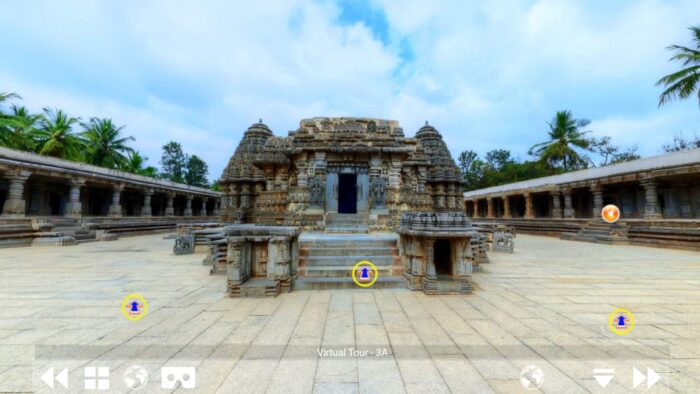Anand Babu made frequent visits to Hampi, a town close to his birthplace. A site having immense civilizational and cultural significance, Hampi plays an important part in the country’s history and heritage. However, Anand’s multiple visits did not result in discovering these stories, until the time he realized the inaccessibility of authentic information. To address this challenge, Anand started learning about monuments and history. He started his initiative called Digitour Technologies, for sharing this learning further.
In this conversation with CSP, Anand talks about his experiences and the interface of technology with tourism.
What is Digitour Technologies all about and what motivated you to start this initiative?
Digitour provides an immersive, multi-lingual, and, interactive audio-visual guided tour exclusively for heritage monuments on mobile phones. The application is available for both Android and iOS apps, and we also provide Mixed Reality, Virtual Reality and immersive reality experiences for viewing heritage monuments.
Being a frequent visitor of Hampi, a UNESCO heritage site close to my birthplace, I was interested in heritage monuments. However, despite my regular visits, especially during my college days, I never had the chance to understand the brighter side of monuments or learn the stories that they harbored for centuries, just because there was a lack of correct and easy availability of information. The scarcity of expert guides and an abundance of fake guides further completed the guided tour experience. The few expert guides, demanding over INR 2000, were unaffordable for many middle-class tourists like me.
As a result, my several trips to Hampi turned out to be simply picnics rather than a learning experience. I soon realized that situation was no different for my friends and colleagues and that inability to access authentic information about monuments is a larger social problem. I started learning about monuments and their history. I was further shocked and pained o know that we are losing some of the custodians of these stories and most authenticated knowledge preserved to time and age.
Since then, the idea of developing digital solutions for heritage monuments kept on brewing in my head. This eventually led to the birth and incubation of Digitour at Deshpande startups. Today, we work with 40 experts in the field of architecture, history, epigraphy and iconography for content creation. The content offered is not only authentic but also one-tenth of the conventional cost.
Apart from boosting heritage tourism, we create digital solutions for several heritage monuments that can be used effectively by educational institutions (5 million students enroll for under graduation with History and Art as the main subject in India) as well. With a perfect blend of technology, creativity and authentic content Digitour is trying to build a legacy.
Why do you think it is important to narrate stories of India through its historical monuments?
By definition “Heritage” is something important to be passed on to next generation. Our monuments are an integral part of it. The best way to preserve heritage is by creating awareness and share its importance with others. Stories are the best to sensitize the millennials. Monuments are something that connects people to their social values and history of where we come from, that in-turn shapes our worldview and understandings of various social and cultural issues.
India’s vast geography is dotted with many such heritage sites. How do you select the ones showcased on your application?
Digitour has a goal to cover 100 important monuments in India. We already completed all the monuments in Karnataka. The support we have got from the Govt. of Karnataka under the Elevate Karnataka and idea to POC initiative has been very helpful. Apart from the two most prominent sites, Hampi and Badami, we have also featured Belur, Halebedu, Somanathapur, Aihole and Pattadakallu. Monuments such as Ajanta caves and Khujaraho are in the final stages of release.
At a later stage, we would like to cover Bagan in Burma (present-day Myanmar) and Angkor Wat temple in Cambodia, as we share rich and ancient connections with these countries. However, since Digitour is an asset heavy model, finding resources is always a challenge. And there is a lot to do in India itself. We are committed to building the legacy sooner are later.

In 2019, Hampi was ranked second in the New York Times’ Must-See Destinations, and the only Indian destination to be on the list. Do you see such rankings and others increasing the popularity of heritage destinations?
I think ranking is just a number. But certainly, this would attract more tourists to Hampi. What is important is, we should use this opportunity to take the tourists to many more other monuments after Hampi. If we fail to engage them with the right information at Hampi, they might not move beyond Hampi. I see this as an economical loss. It is for this reason, we never sought to limit ourselves to one destination, one state, or one region. Every other monument we work is equally important in its own way.
How can technological interventions be used to revive heritage tourism? Does it have a spillover effect on tourism-related development as well in and around a particular destination?
Technology is becoming pervasive and a reality in every sector. Heritage is no exception. The adoption of technology in the heritage space is still in its nascent stage in India and also in many Southeast Asian countries. However, the scope of innovation and the possibility of effectively merging technology with heritage to promote tourism at large is immense. Heritage tourism is one of the main economic contributors of growth in the tourism industry and also attracts many international visitors. Furthermore, heritage visitors tend to stay longer and spend more per day (two and a half times more) during their travels, thus leading to significantly greater per trip economic impact.
Technologies connect tourists with monuments, with the destinations of their choice and open gateways to exploration. With new and adequate use of technology, we can build world-class infrastructure facilities, give out the right information in the most engaging ways such as audio-guided tours, enhance the quality of light and sound shows, which are common in most destinations and so much more. Every corner of India has monuments. We are just not leveraging their potential fully. It is high time to use technology to promote Heritage tourism in India. Digitour working on the same line.
What factors can lead to heritage tourism being one of the hallmarks of Indian soft power and cultural influence in the world?
India is amongst the very few countries that have such a rich and diverse culture, as well as a civilizational legacy that continues even today. The very DNA of India’s uniqueness is its culture, heritage and arts that remain unparalleled in the world. And there is increasing global awareness about India’s uniqueness.
However, we are yet to create an apparatus that successfully conveys the uniqueness of Indian experiences and the brighter side of India through tourism. Needless to say, we should use this to build “Brand India”. In my opinion, if we succussed in connecting tourists with monuments, it develops respect towards the country and that is true soft power.
Today 37% of the global tourist movement has cultural motivation. Our vision at Digitour is simple, we want all these great heritage monuments to reach every youngster in India and across the world (1+ billion people) - so that each one should feel proud of our heritage monuments and appreciate its intricate, complex, scientific architecture and beauty.
Image courtesy: Digitour Technologies





